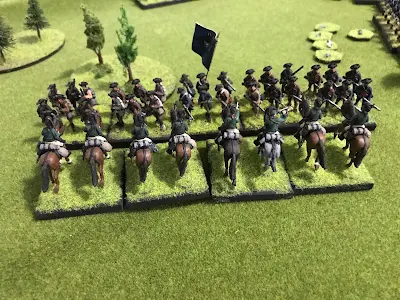Russian commander massed his infantry and guns together and marched to cross the river South of the bridge and church. He hoped to use his faster speed (marching in column) to get to the river and cross it and then close with the British infantry. He unlimber his guns as quickly as he could to get them into play and cause some damage to the enemy infantry. He sent his cavalry north of the bridge and hoped to cause mischief there.
The British formed line with his infantry and advanced forward in a most stately manner. His Royal Horse Artillery took the high ground to get into a good firing position while the Light Cavalry Brigade protected their exposed flank.
Once the Russian infantry reached the river they came under fire from the superior range of the British infantry. Casualties were light but both forward battalions suffered a couple morale chips. (The morale rules are simple but deadly. For every morale chip you subtract one each from every dice thrown. Since dice are used for movement and firing this can have a cumulative effect.)
The Russian cavalry quickly crossed the river and charged their enemy. The Hussars tangled with the Light Brigade (who counter charged) while the Uhlans took on the guns and quickly over ran them! The Light Brigade routed the Hussars and sent them flying.
Seeing the disaster to his flank the British brigadier turned the 23rd to cover his exposed flank. He then spent two command points to fire twice at the Russian columns in front of him to cause as much damage as he could. (Each unit has some many command points in the game. Each turn that unit can spend a CP to do an extra action. Once you spend a CP it is gone).
As the Russians closed with the British line they took one more volley before close quarters fighting. The British easily saw them off due to the morale chips they had acquired. As they retreated they blocked the guns so the British infantry was given a break. With a single battalion left the Russian commander turned to his cavalry who were being chased off the field by the Light Brigade. With no hope of victory he shrugged his shoulders and thought how best to compose his report and try and salvage something from the disaster.
If you liked this action and are curious about the rules used here is a link to my explanation of how the Rules work. They are a fun set of rules which capture the flavor of the period and provide a fun and fast game.
https://bravefusiliers.blogspot.com/2019/11/rules-i-use-for-wargaming-crimean-war.html
It was great fun to bring out my Crimean Armies. These are my oldest miniatures and I have a great sentimental attachment to both the armies and the period. So, I will be planning on a couple more games in the Crimean War period soon.


















































